<< Previous | Displaying results 4851-4900 of 6769 for "" | Next >>
Nazi propaganda postcard showing a crowd of saluting Germans superimposed on an enlarged image of Adolf Hitler with a member of the SA (Storm Trooper) who holds a swastika flag. Munich, Germany, ca. 1932.
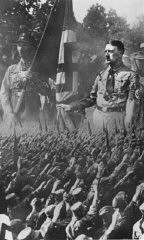
At a rally, members of the Hitler Youth parade in the formation of a swastika to honor the Unknown Soldier. Germany, August 27, 1933.
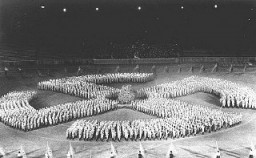
Group portrait of German girls posing outside their school in front of a Nazi flag. Among those pictured is Lilli Eckstein six months before she was expelled from the school for being Jewish. Heldenbergen, Germany, 1935.

German spectators at a Nazi rally stand alongside a monument decorated with Nazi flags and a swastika emblem in Berlin. Germany, 1937.
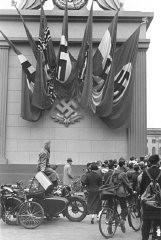
A Maypole topped with a swastika is raised for a May Day parade in the Lustgarten in Berlin. The May holiday became an important celebration in the Nazi calendar. Germany, April 26, 1939.
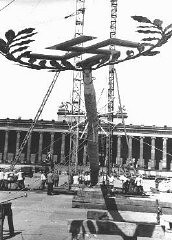
1943 still life of a violin and sheet of music behind prison bars by Bedrich Fritta (1909–1945). Fritta was a Czech Jewish artist who created drawings and paintings depicting conditions in the Theresienstadt camp-ghetto. He was deported to Auschwitz in October 1944; he died there a week after his arrival.
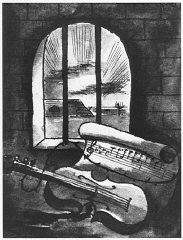
1943 painting of the Vltava River in Prague created from a photograph by Bedrich Fritta when he was imprisoned in Theresienstadt. Fritta (1909-1945) was a Czech Jewish artist who created drawings and paintings depicting conditions in the Theresienstadt camp-ghetto. Fritta was deported to Auschwitz in October 1944. He died there a week after his arrival.
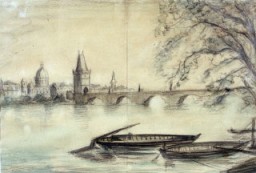
1943 portrait of Edgar Krasa drawn by Leo Haas in Theresienstadt. Haas (1901-1983) was a Czech Jewish artist who, while imprisoned in Nisko and Theresienstadt during World War II, painted portraits and produced a large volume of drawings documenting the daily life of the prisoners.
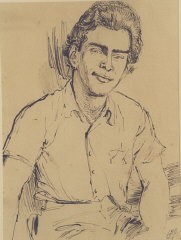
1943 watercolor landscape of Theresienstadt painted by Otto Samisch. Despite the terrible living conditions and the constant threat of deportation, Theresienstadt had a highly developed cultural life.
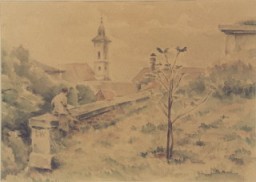
Photograph showing Helene Reik's family members and friends gathered in March 1941 in Brazil. After her deportation to the Theresienstadt ghetto in Czechoslovakia, Helene yearned to record what was happening to her. This photograph was sent to Helene, who used it as paper for her diary in Theresienstadt. Helene’s makeshift diary offers wistful memories of her husband and parents who died before the war, loving thoughts of her family who had left Europe in 1939, and a firsthand account of the illness…

Photograph taken in May 1915 of Helene Reik's children. After her deportation to the Theresienstadt ghetto in Czechoslovakia, Helene yearned to record what was happening to her. This photograph was sent to Helene, who used it as paper for her diary in Theresienstadt. Helene’s makeshift diary offers wistful memories of her husband and parents who died before the war, loving thoughts of her family who had left Europe in 1939, and a firsthand account of the illness and hospitalization that ultimately…
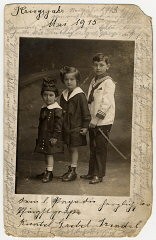
Photograph showing Kurt, Helene Reik's son, and his wife, while on vacation in April/May 1938 in Kupari, Croatia. After her deportation to the Theresienstadt ghetto in Czechoslovakia, Helene yearned to record what was happening to her. This photograph was sent to Helene, who used it as paper for her diary in Theresienstadt. Helene’s makeshift diary offers wistful memories of her husband and parents who died before the war, loving thoughts of her family who had left Europe in 1939, and a firsthand…
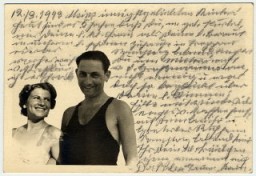
Photograph showing Margarida, Helene Reik's granddaughter, playing on a field in Teresopolis, Brazil, in April 1940. After her deportation to the Theresienstadt ghetto in Czechoslovakia, Helene yearned to record what was happening to her. This photograph was sent to Helene, who used it as paper for her diary in Theresienstadt. Helene’s makeshift diary offers wistful memories of her husband and parents who died before the war, loving thoughts of her family who had left Europe in 1939, and a firsthand…
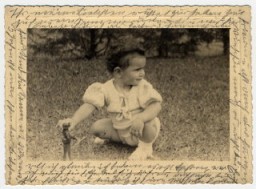
Photograph showing Kurt, Helene Reik's son, holding his baby Margarida, in Rio de Janeiro in 1940. After her deportation to the Theresienstadt ghetto in Czechoslovakia, Helene yearned to record what was happening to her. This photograph was sent to Helene, who used it as paper for her diary in Theresienstadt. Helene’s makeshift diary offers wistful memories of her husband and parents who died before the war, loving thoughts of her family who had left Europe in 1939, and a firsthand account of the…
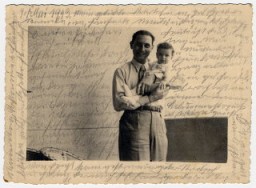
A photograph of Jewish children in the Theresienstadt ghetto taken during an inspection by the International Red Cross. Prior to this visit, the ghetto was "beautified" in order to deceive the visitors. Czechoslovakia, June 23, 1944.
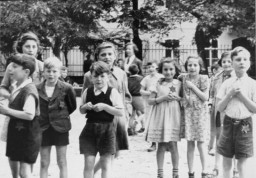
A scene staged by the Nazis for the International Red Cross inspection of the Theresienstadt ghetto. The people are probably watching a soccer match. Czechoslovakia, June 23, 1944.
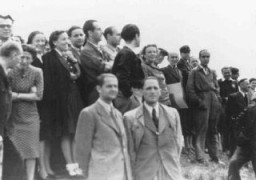
A scene staged by the Nazis for an International Red Cross inspection of the Theresienstadt ghetto. Czechoslovakia, June 23, 1944.
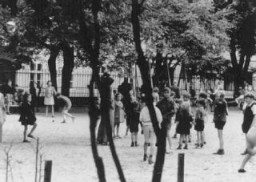
Photograph of a Jewish policeman taken during an International Red Cross visit to the Theresienstadt ghetto. The SS deceived the delegation into believing that the ghetto was a self-administered Jewish settlement. Czechoslovakia, June 23, 1944.
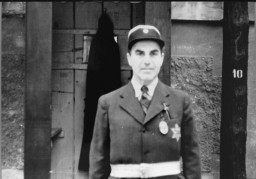
In a scene from a Nazi propaganda film, Dr. Paul Eppstein (right), Council of Elders chairman, addresses Dutch Jews. Theresienstadt ghetto, Czechoslovakia, August 1944.
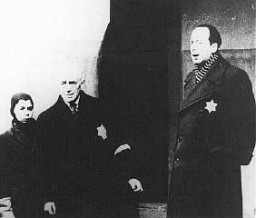
A Jewish girl, one of the "Tehran Children" (about 1,000 Polish Jewish refugee children who reached Palestine), upon arrival at the Atlit train station. Palestine, February 18, 1943.
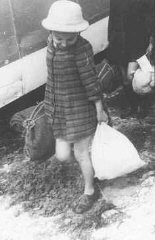
A group of Polish Jewish refugee children (known as the "Tehran Children") arrives in Palestine via Iran. Atlit reception camp, Palestine, February 18, 1943.
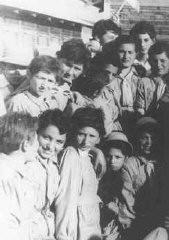
A group of Polish Jewish refugee children known as the "Tehran Children" after their arrival in Palestine. Atlit, Palestine, February 18, 1943.
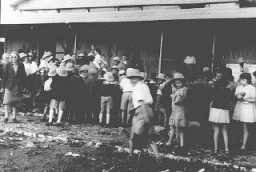
A group of Polish Jewish refugee children, known as the "Tehran Children," arrives in Palestine via Iran. Atlit reception camp, Palestine, February 18, 1943.

Henrietta Szold (left, in hat), founder of the Hadassah Women's Zionist Organization, welcomes some of the Polish Jewish refugee children known as the Tehran Children, upon their arrival in Palestine. Atlit, Palestine, February 18, 1943.
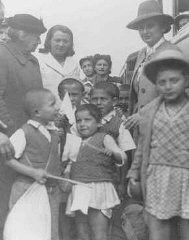
A nurse helps one of the "Tehran Children," Polish Jewish refugees, disembark from a train at the Atlit refugee camp. Atlit, Palestine, February 18, 1943.
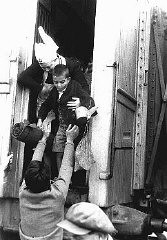
Some of the "Tehran Children," Polish Jewish refugees, study Hebrew in a Jewish National Fund youth village near Jerusalem. Palestine, March 9, 1943.
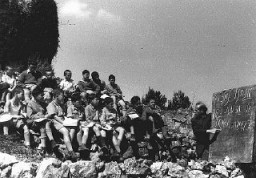
A group of Polish Jewish children (known as the "Tehran Children"), who arrived in Palestine via Iran, at the Mikveh Israel agricultural village. Palestine, February or March 1943.
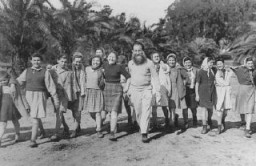
Polish Jewish refugee youth known as the "Tehran Children," who arrived in Palestine via Iran, learn agricultural skills. Ayanot, Palestine, 1943.
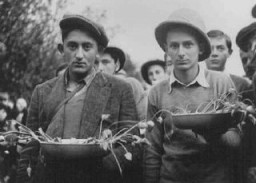
Polish Jewish refugee children known as the "Tehran Children" gather at a memorial stone dedicated to the Jewish refugees who died when the Patria (a ship bound for Palestine) sank in November 1940. Atlit, Palestine, 1943.
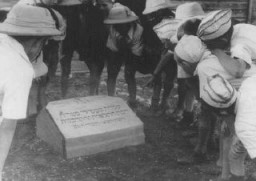
Eliahu Dobkin of the Jewish Agency (left) and Henrietta Szold, founder of the Hadassah Women's Zionist Organization (second from left), await the arrival of the "Tehran Children." Atlit, Palestine, February 18, 1943.
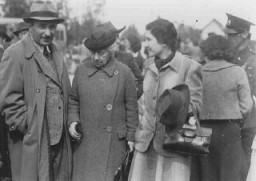
Shortly after liberation, an emaciated concentration camp inmate stands between two members of the International Red Cross. Theresienstadt, Czechoslovakia, May 1945.
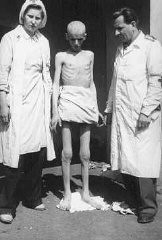
Jewish children sheltered by the Protestant population of the village of Le Chambon-sur-Lignon. France, 1941.

Page from the diary of Peter Feigl, a Jewish child hidden in the Protestant village of Le Chambon-sur-Lignon. The photos show his parents, who perished in a concentration camp. The text is in French and German. Le Chambon-sur-Lignon, France, 1942-1943.
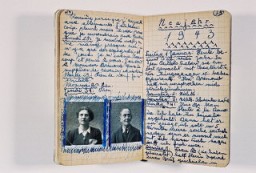
Photo of Peter Feigl, a Jewish child hidden in the Protestant village Le Chambon-sur-Lignon. Le Chambon, France, August 9, 1943.
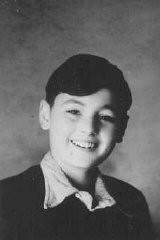
View of Le Chambon, where most of the village's Protestant population hid Jews from the Nazis. Le Chambon-sur-Lignon, France, date uncertain.
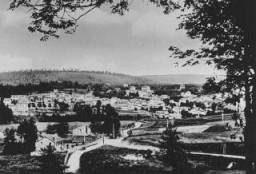
Postcard of a pension (a small hotel) in Le Chambon which served as a refugee home for children sheltered from the Nazis. Le Chambon-sur-Lignon, France, date uncertain.

Group of Jewish children who were sheltered in the children's home Maison des Roches, which was directed by Daniel Trocme (back, center, with glasses). Le Chambon-sur-Lignon, France, between 1941 and 1943.
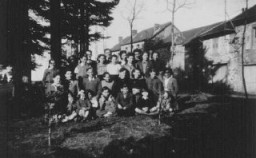
Portrait of Asael Bielski, a founder of the Bielski brothers' Jewish partisan unit in Naliboki forest. He was killed on the Soviet front in 1944. Novogrudok, Poland, before 1941.
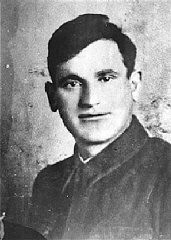
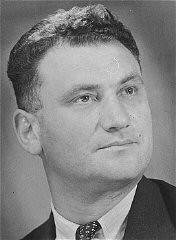
Postwar portrait of Alexander Bielski, a founding member of the Bielski partisan group. 1945–48.

Members of the Bielski partisan group at the site of a mass grave shortly after liberation. Poland, 1945.
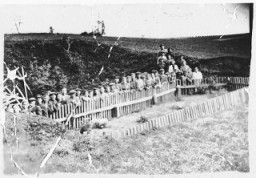
Postwar portrait of Piotr Kolenda. He was a landowner from Nowogrodek who knew both the Dzienciolski and Bielski families before the war. During the war he helped hide the women before they could safely go to the forest and continued to assist members of the Bielski group while they were in the forest.
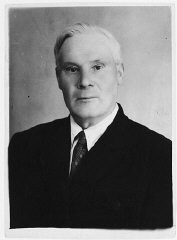
Wedding portrait of former Bielski partisan, Berl Kagan. Emden, Germany, April 3, 1948. Pictured from left to right are Ita Rubin (the bride), her mother, Sarah Rubin, and Berl Kagan. All three were passengers on the Exodus 1947.
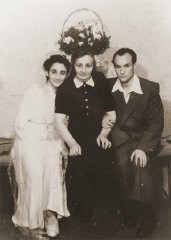
Portraits of Martha and Waitstill Sharp from an unknown newspaper. Published before they left for Europe on a relief mission with the Unitarian Service Committee.
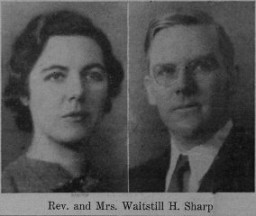
Polish-Jewish refugees seeking to leave Europe arrive in Lisbon. Following the German invasion of France, Jewish and non-Jewish refugee assistance organizations relocated their headquarters to Lisbon, the only neutral European port from which refugees could depart to North and South America. Lisbon, Portugal, June 21-22, 1940.
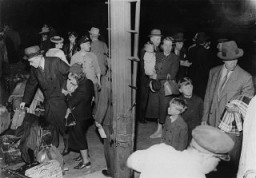
A wounded partisan is treated in a field hospital belonging to the Shish detachment of the Molotov brigade. Among those pictured are Dr. Ivan Khudyakov, the brigade's physician (second from the right), and Fanya Lazebnik (Faye Schulman), a photographer and partisan nurse (left). The wounded partisan's name is Sergei. Pinsk, 1942–44.
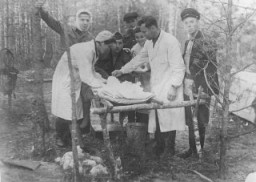
Group portrait of members of the Hashomer Hatzair socialist Zionist youth movement. Pictured in the back row, left to right, are: Tzvi Braun, Shifra Sokolka and Mordechai Anielewicz. Seated in front are Moshe Domb and Rachel Zilberberg ("Sarenka"). Warsaw, Poland, 1938.
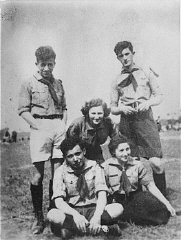
Zivia Lubetkin, a founder of the Jewish Fighting Organization (ZOB) and participant in the Warsaw ghetto uprising. Poland, date uncertain.
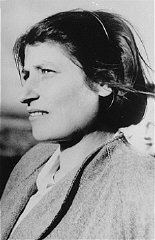
Yitzhak (Antek) Zuckerman, Zionist youth leader and a founder of the Jewish Fighting Organization (ZOB). He fought in the Warsaw ghetto uprising. Place and date uncertain.

Portrait of Josef Kaplan. Kaplan was a youth movement leader. He was also a leader of the Warsaw ghetto underground and Jewish Fighting Organization (ZOB). He was caught preparing forged documents and was killed. Poland, before September 1942.
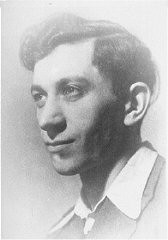
We would like to thank Crown Family Philanthropies, Abe and Ida Cooper Foundation, the Claims Conference, EVZ, and BMF for supporting the ongoing work to create content and resources for the Holocaust Encyclopedia. View the list of donor acknowledgement.